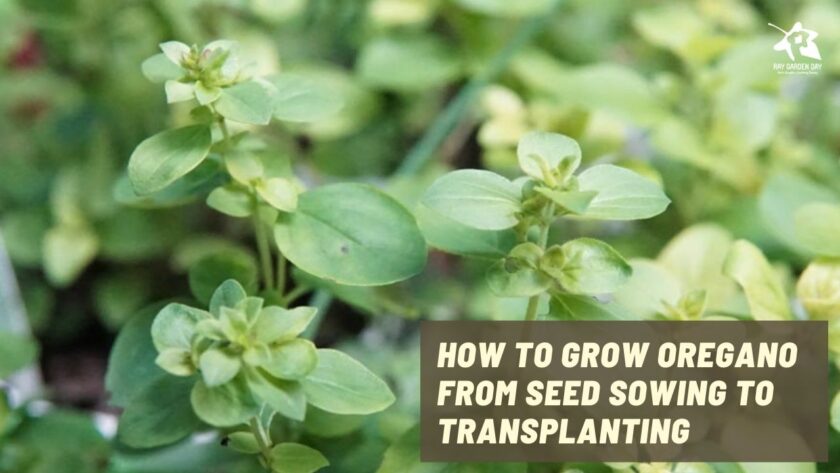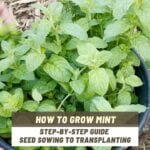Herbs and spices add essential elements of flavor in modern food preparation. For example, growing oregano adds unique flavors, color, and variety to our food.
Oregano, or Origanum vulgare, is a member of the mint family.
Typical dishes to use oregano with are pizza and pasta. In addition, you can find them in Mediterranean and Mexican dishes. Both dried or fresh oregano are used as a seasoning or oil-based marinade.
Herbs are easy to grow at home, and oregano is no exception. You can sow oregano seeds directly in the ground or start them inside.
I’ll show you how to sow oregano seeds indoors from inside our small greenhouse. But, if you’re following along, the process will be the same regardless of where you are indoors.
Oregano is a summer perennial herb; it prefers full sun but overwinters well in mild winter. Recommended for zones 4-10, but lookup USDA plant zone for your area to determine when to start your oregano seed indoors.
Tools and materials you’ll need
- Plants seed starting pots, starting cells, or seed flats
- Seed-starting mix
- Heirloom oregano seeds
- Plant label
- A Sharpie permanent marker
Prepare coconut coir seed starting mix
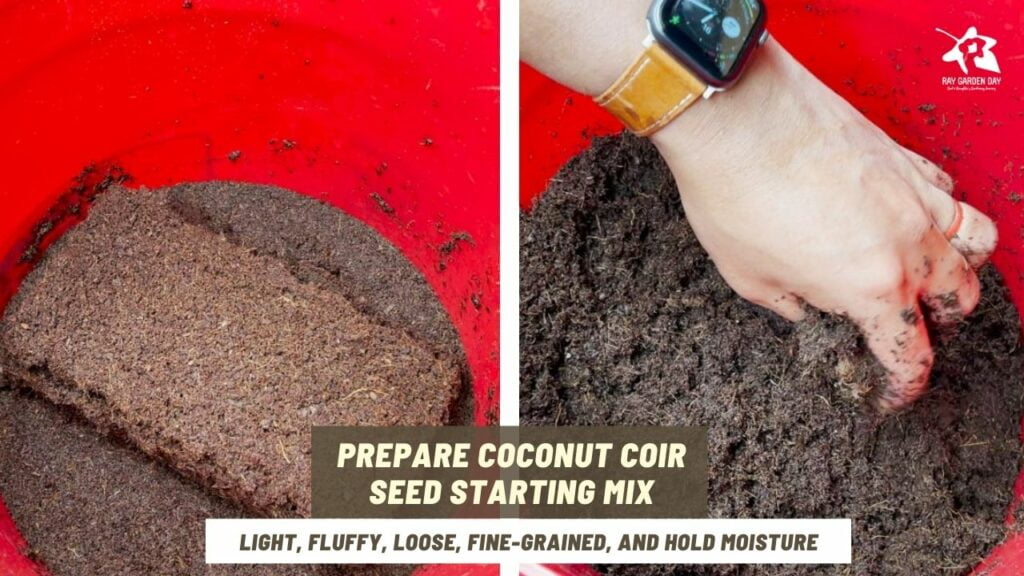
Prepare coconut coir seed starting mix You can buy pre-made or make your seed-starting mix for this part. An ideal seed starting medium should have these qualities, light, fluffy, loose, fine-grained, and hold moisture. Nothing too fancy or complicated here; I’ll use my trusty coconut coir pith and water. It’s fine enough and easy to work into small openings of cells in a seed starter tray. I place a 1.4 lbs coconut coir brick into a 5-gallon bucket, then add one and a half a gallon of water. Let it sit for 30 minutes to soak up all the moisture and fully break down. Then massage with your hands to the desired consistency. Add more water if too dry or wring out if it’s too wet.
Remember that the commercially available seed starting mix that you buy may contain chemicals. Some are necessary to help keep the mix hydrated. In addition, it may likely contain fertilizer which isn’t required for germination.
Fill the containers or seed starting cells
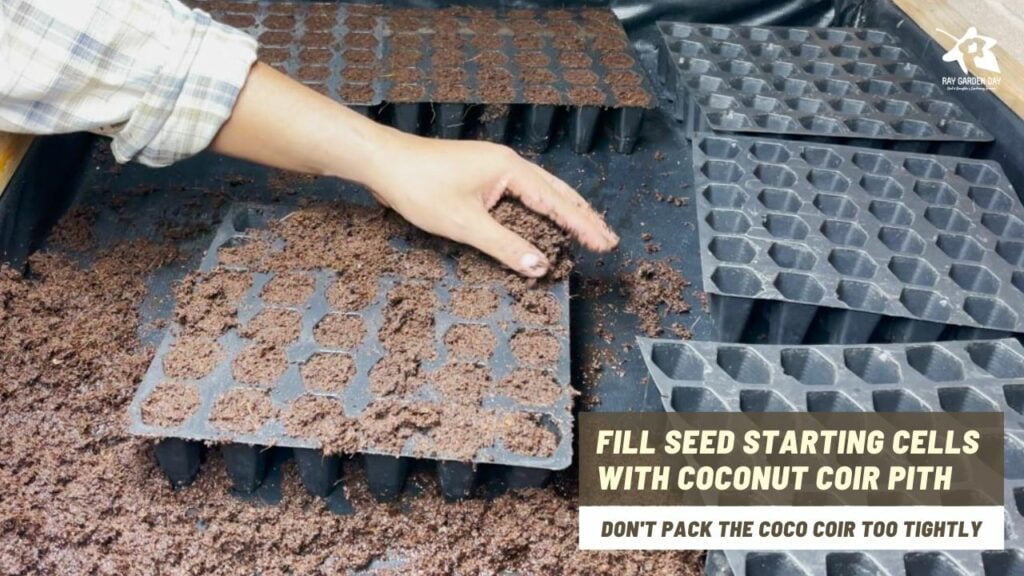
Fill the seed starting cells with coconut coir Fill seed starting cells with ready starting mix all the to the top. I find it easier and faster to put a generous amount of coconut coir over the cells. Spread it around. Then squeegee off with the palm of your hand. Apply enough pressure to firm the top of the mix for each cell and help the starting mix settle. You pack the seed starting mix too tightly into the container. We want it to remain fluffy and aerated.
I’m using a 72 cells plant starter tray completed with a dome lid.
If you’re using 2 inch or larger seed starter pots, fill the containers to three-quarters full with seed starting mix.
Sow the oregano seeds
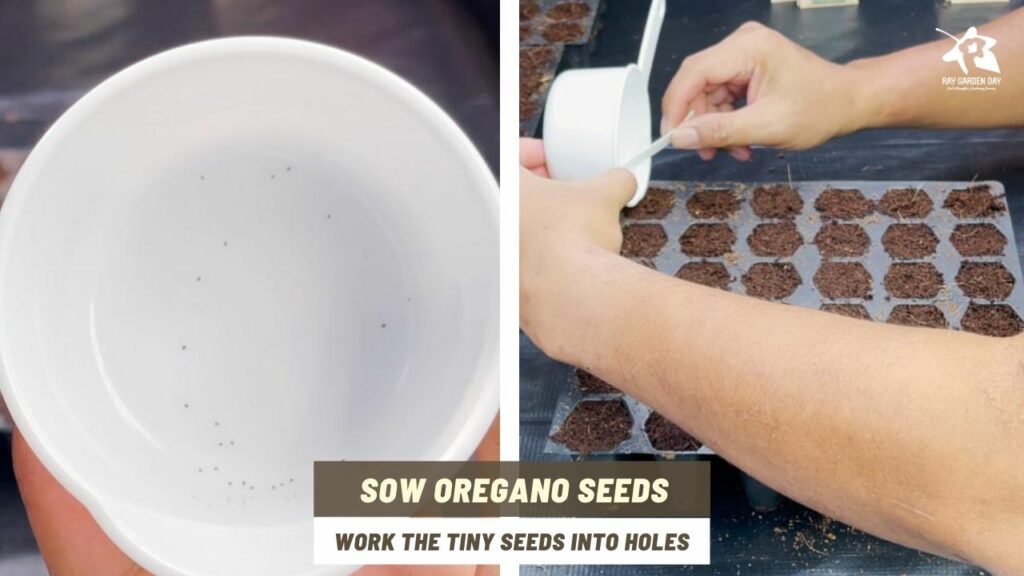
Sow the oregano seeds Now that seed start cells are ready, it’s time to sow the oregano seeds. I use a pencil to make a quarter-inch-deep hole in the seed starting mix of each cell. Oregano seeds are tiny. It’s easier to separate the number of seeds you’re planning to grow into a white measuring cup or a spoon. I then scoop the seed out into the pre-made hole using a plastic label instead of my finger.
Here’s where you’ll enjoy sowing into a larger seed starting container because you don’t have to worry about being precise. Instead, just sprinkle one or two oregano seeds on top of the starting mix.
I’m sowing Non-GMO Heirloom oregano seeds.
Cover the oregano seeds with starting mix
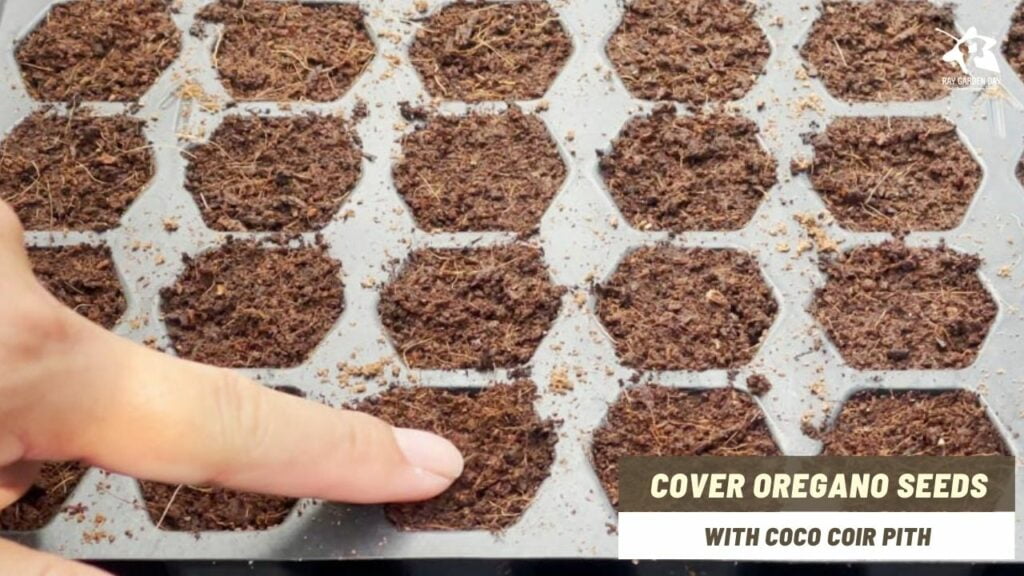
Cover the oregano seeds with starting mix Push the starting mix back into the hole to cover the oregano seeds. Firm it again but remember not too tightly. Repeat for each cell.
Cover the seed with an extra quarter-inch layer of starting mix for larger containers.
Water from the bottom
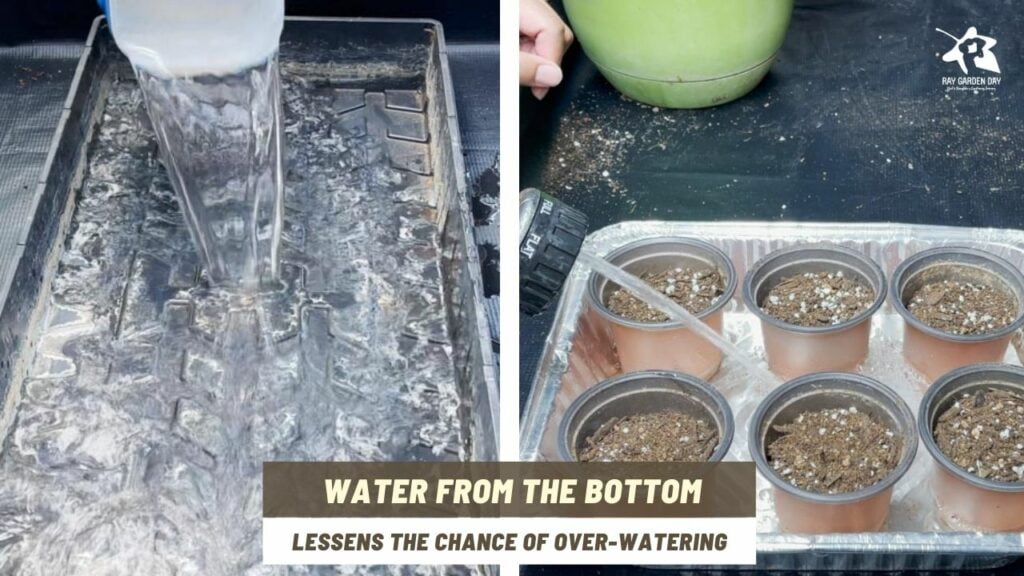
Water from the bottom Now that we have sown our oregano seeds, it’s time to water them. And this is why I like to start my seeds in a 72 cells seedling tray because it comes as a complete kit. The watertight base tray makes watering from the bottom more efficient. Just fill it with water to about half an inch to an inch deep, depending on how moist your starting mix is. The seed starting mix will soak water through the cell or container drainage holes. Allow 10-20 minutes for the water to permeate to the top of the seed starter medium. Use your finger to feel if the moisture has reached the top of the mix.
If you’ve been following using two-inch seed starting pots, your base tray could be anything that’s watertight. One of my favorite things to use is aluminum foil pans with clear plastic lids. You can find them in dollar stores. They are useable for a few seasons’ use and recyclable. Containers that come with store-bought rotisseries work great too.
Watering from the bottom lessens the chance of over-watering and spillage. Water from the top is optional, but mist lightly.
Label your seed starting tray using a label and marker.
Control humidity with lids
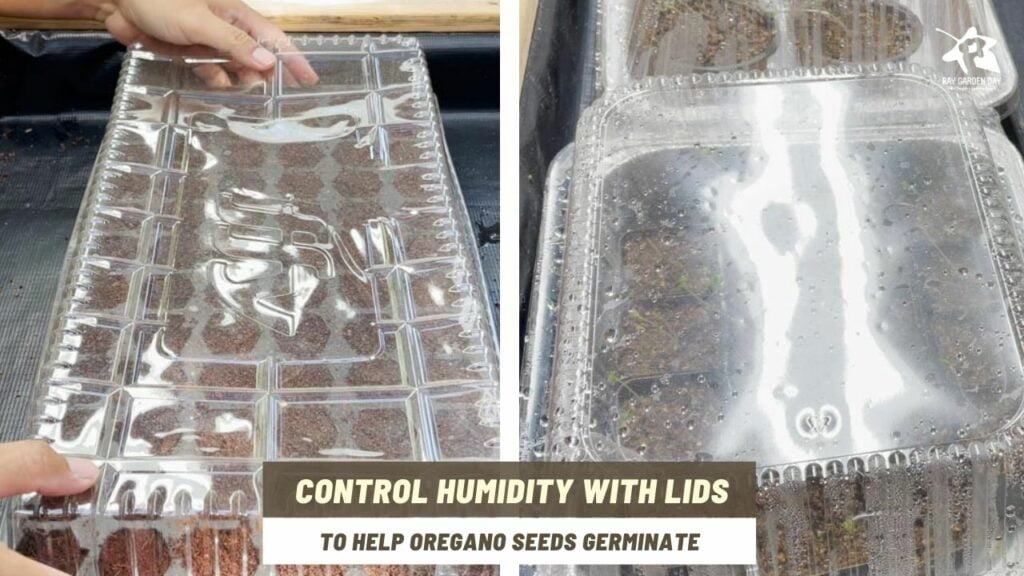
Control humidity with lids To help the oregano seeds germinate and sprout, we’ll need to control the humidity levels. We also need to provide them with optimal temperature and light. More on that later.
Begin by covering the seed starting tray using the accompanying lid. Doing so reduces moisture evaporation and increases humidity and warmth.
Provide optimal temperature
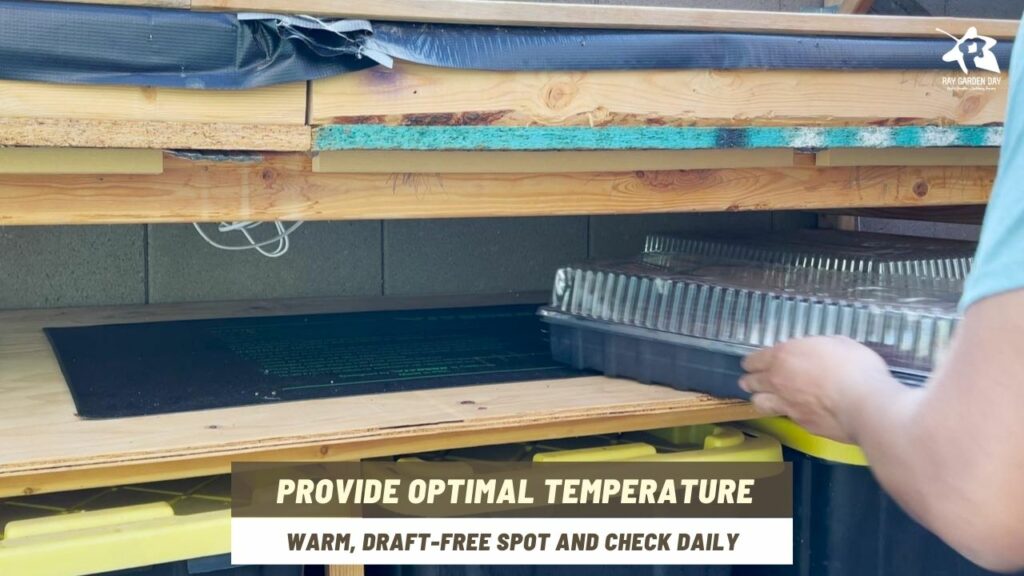
Control humidity with lids and place on heat mat Oregano seeds germinate best when the soil temperature is around 70 degrees Fahrenheit. Put your container in a warm, draft-free spot where you can check on it daily. Somewhere that’s out of the way, so it’s not going to get stepped on.
An alternative is buying a heating mat made for germinating seeds. I have a couple of these on a dedicated shelf in the greenhouse. So that’s where my oregano seeds tray will stay, where I’ll check on it daily.
Remove the plastic cover and provide light
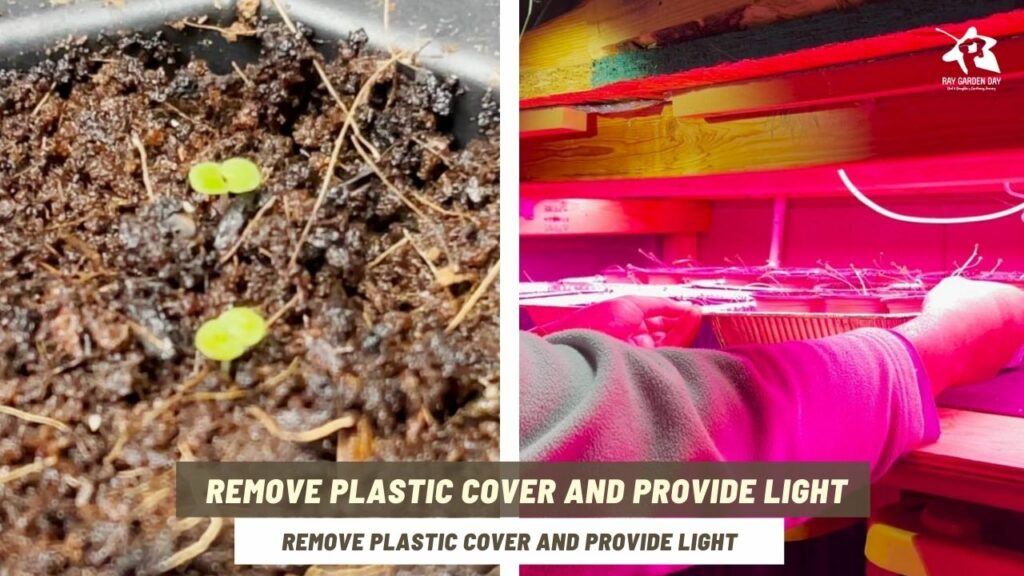
Remove dome lid and grow under light Once the oregano seeds germinate and tiny seedlings appear, remove the dome lid right away. Next, move the seedling containers into indirect lighting. Continue to provide the seedlings with warmth that induces root growth.
When true leaves have formed, the oregano seedlings can begin photosynthesis. So move them under a light source.
My oregano seedlings tray remains on the same shelf to get their light from the overhead LED. The lights are on a cycle of 16 hours on and 8 hours off to allow the oregano seedlings to rest.
Water and fertilize oregano seedlings
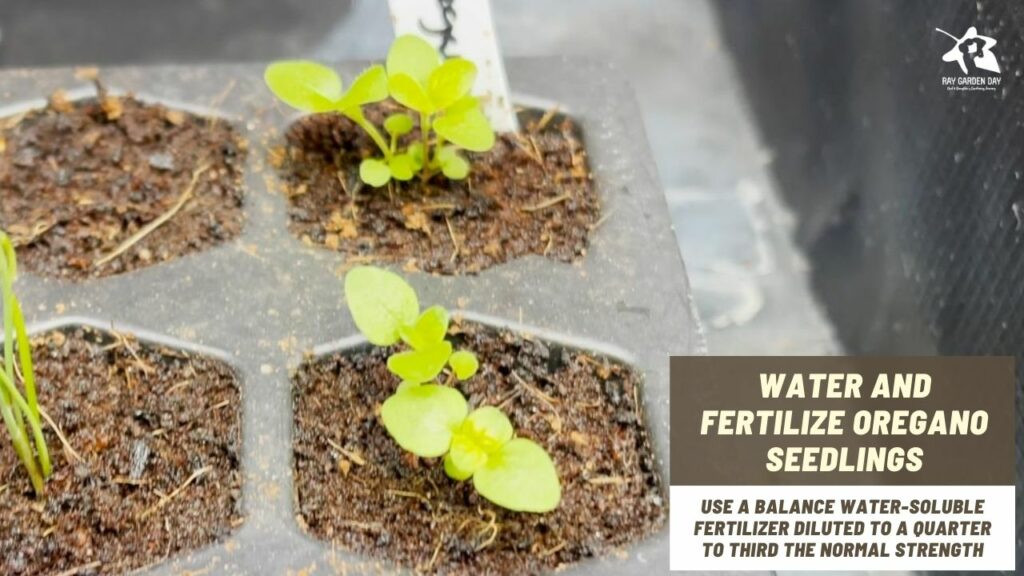
Water and fertilize once true leaves formed During the growth stage of oregano seedlings, they need both the starting mix to remain moist and offer good air circulation. New true leaves are forming. The seedlings are actively photosynthesizing. Continue to bottom watering to help reduce the risk of fungal-born diseases. Because the coconut coir starting mix contains hardly any nutrients, you’ll need to begin fertilizing.
Use a balanced, water-soluble fertilizer diluted to a quarter to a third of the normal strength. Bottom feed the oregano seedlings weekly.
Potting up oregano seedlings
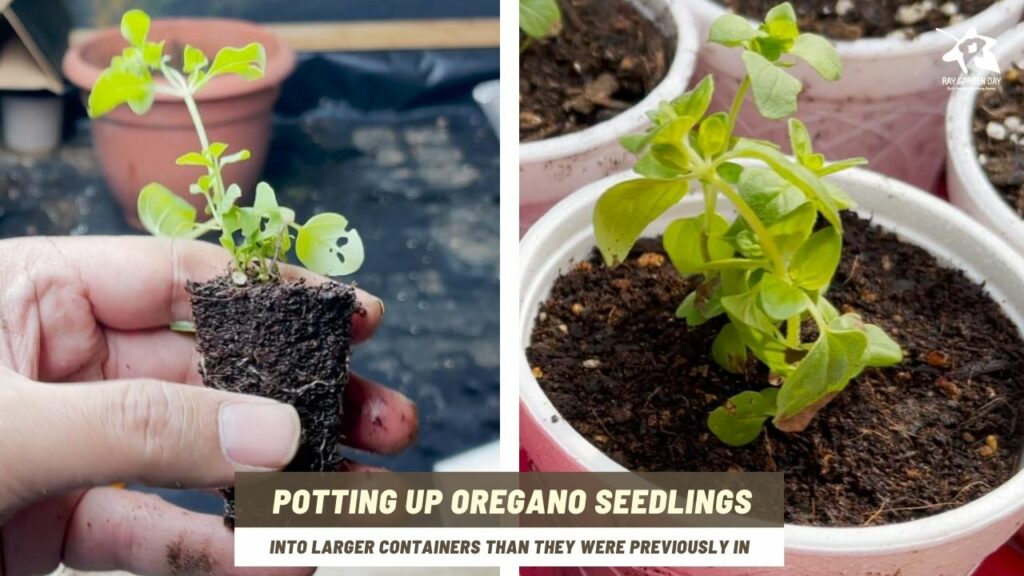
Potting up oregano seedlings A month or so later, the oregano seedlings should be a couple of inches tall. Then, it is time to transplant them into larger containers. Gardeners refer to this process as potting up. Doing so will allow the roots more room to grow.
It is also a perfect time to do some thinning. First, remove all but one seedling growing in the same pot. To do so, you can either separate the oregano seedlings into individual pots or cut all but one most vigorous plant. Avoid pulling as this will damage the roots.
Harden off oregano seedlings
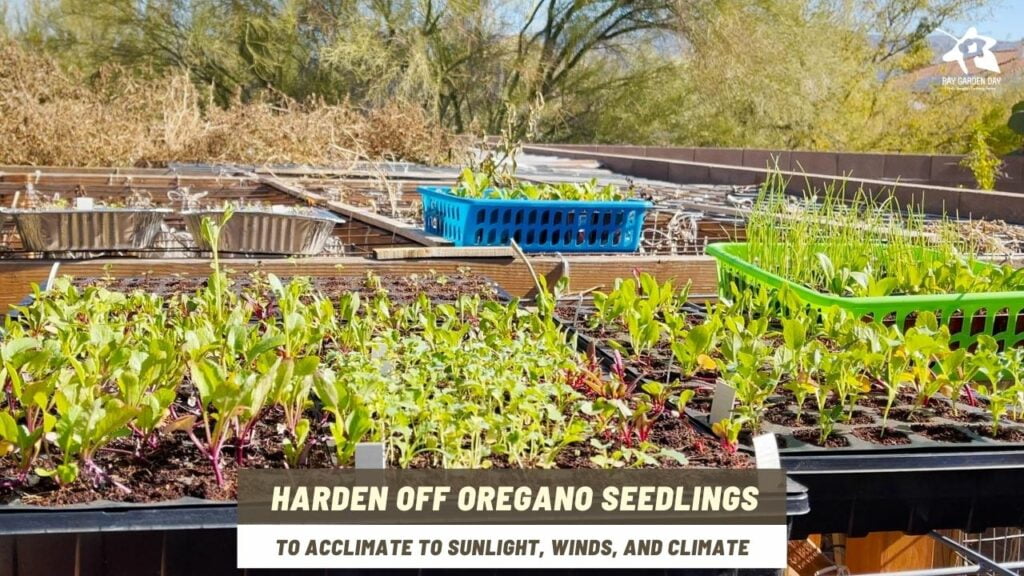
Hardening off oregano seedlings At eight weeks and now in larger containers, it’s time to harden off the oregano seedlings. The process is about gradually introducing the young plants to outdoor conditions. It gives them a chance to acclimate to sunlight, winds, and climate in your garden.
When the temperature warms outside, move the oregano seedlings to a sunny spot outdoors for an hour on the first day. Then bring the seedlings back indoors. Increase the lengths of outdoor sun exposure time each day for two weeks. By the end of the hardening off period, you can leave them outdoors all day and night. Finally, the young oregano seedlings are ready for transplanting.
Transplant oregano seedlings
To transplant the bushy, healthy young oregano young plants into the garden. Prepare a weed-free area large enough for a 12 to 16 inches spread. Dig a hole large enough to house the root ball. Carefully remove the oregano seedling from its container and loosen the root ball to encourage the roots to grow out. Place the plant into the planting hole, ensuring the root ball is level with the surrounding soil. Backfill with soil to the top of the root ball. Firm the surrounding soil with your hands. Apply an inch or so layer of mulch to help reduce water evaporation. Water your newly transplanted oregano seedlings thoroughly.
FAQ
When to start oregano seed indoors?
Sow oregano seeds indoors 4-10 weeks before the last frost in spring.
Is it better to direct sow oregano seeds?
Direct sowing oregano instead of growing indoors means the young plant will adjust to its growing conditions faster. As a result, there’s no transplanting stress. You also avoid the need to do the harden-off process of exposing transplants (seedlings) gradually to outdoor conditions.
Is oregano better fresh or dried?
The flavor of fresh oregano is mild in early spring to more intense in mid-summer. Dried oregano results from fresh leaves harvested in the summer, cured, and grounded to enhance the flavor.
What does fresh oregano smell like?
Sweet and mildly spicy aroma. It gives dishes a tangy taste and smell and is often used in spice and rub-based marinades.
